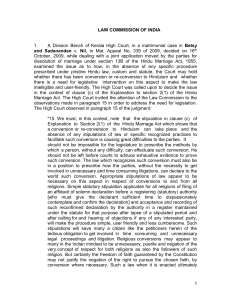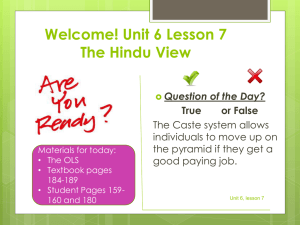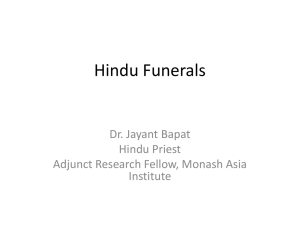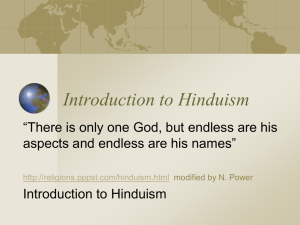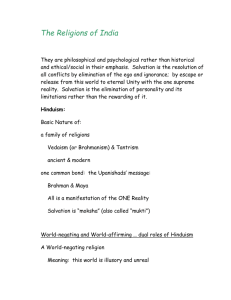Christianity and World Religions
advertisement
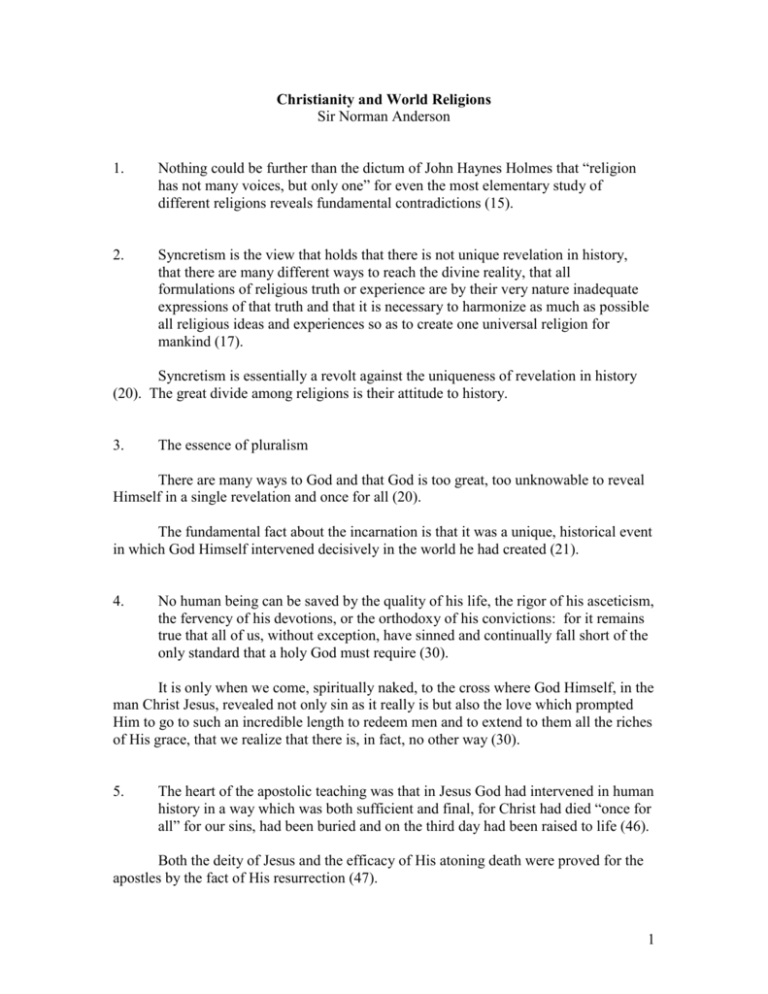
Christianity and World Religions Sir Norman Anderson 1. Nothing could be further than the dictum of John Haynes Holmes that “religion has not many voices, but only one” for even the most elementary study of different religions reveals fundamental contradictions (15). 2. Syncretism is the view that holds that there is not unique revelation in history, that there are many different ways to reach the divine reality, that all formulations of religious truth or experience are by their very nature inadequate expressions of that truth and that it is necessary to harmonize as much as possible all religious ideas and experiences so as to create one universal religion for mankind (17). Syncretism is essentially a revolt against the uniqueness of revelation in history (20). The great divide among religions is their attitude to history. 3. The essence of pluralism There are many ways to God and that God is too great, too unknowable to reveal Himself in a single revelation and once for all (20). The fundamental fact about the incarnation is that it was a unique, historical event in which God Himself intervened decisively in the world he had created (21). 4. No human being can be saved by the quality of his life, the rigor of his asceticism, the fervency of his devotions, or the orthodoxy of his convictions: for it remains true that all of us, without exception, have sinned and continually fall short of the only standard that a holy God must require (30). It is only when we come, spiritually naked, to the cross where God Himself, in the man Christ Jesus, revealed not only sin as it really is but also the love which prompted Him to go to such an incredible length to redeem men and to extend to them all the riches of His grace, that we realize that there is, in fact, no other way (30). 5. The heart of the apostolic teaching was that in Jesus God had intervened in human history in a way which was both sufficient and final, for Christ had died “once for all” for our sins, had been buried and on the third day had been raised to life (46). Both the deity of Jesus and the efficacy of His atoning death were proved for the apostles by the fact of His resurrection (47). 1 Nothing else can explain the spontaneous joy of the primitive church, the dramatic transformation of the apostolic band from an attitude of disillusionment and cringing cowardice into that of men whom no persecution could silence, or the triumphant faith of their witness to a crucified felon as the risen Lord of life (47). 6. The Christian faith cannot survive the surrender of particularity (47). The uniqueness of the Christian faith consists in the fact that it was founded on a unique historical event (47). For there is all the difference in the world between a statement about the nature of God and a report that God has, at a certain time and place, acted in a certain way (48). The tradition was this: Christ died for our sins in accordance with the scriptures, that he was buried, that he was raised on the third day in accordance with the scriptures (48). God comes right down from the heights of absolute being into time and space; down to humanity, down to the very foundations of the nature He had Himself created. But He goes down to come up again and bring the whole ruined world up with Him (54). 7. Hinduism is more a culture than a creed for it covers a plethora of primitive practices and beliefs alongside a number of highly sophisticated systems of philosophical thought (57). In India the whole genius of the people seems to have been turned inwards to contemplation and the development of speculative thought. Traditionally the Hindu does not attach great importance to the events that occur in the three-dimensional world of space and time, or to the human beings that take part in them. Thus the Hindu has taken pride in the fact that Hinduism is a religion of pure ideas in contrast to a religion that is dependent on history (57). 8. For the Christian the truths which Jesus exemplified and taught cannot be separated from the historical facts (57). It is primarily through what Jesus WAS and DID that God’s nature and character stand revealed and it is meaningless to speak of the efficacy of His atoning death unless He did in fact die. But it is true that, with the event, we also need the interpretation put on that event by the apostles (58). 2 9. The Christian faith, based on the apostolic testimony, is that God acted in Jesus in a way which was unique, which was never to be repeated, and which constitutes the decisive point in human history (58). A Hindu may commit himself to an avatar without any conviction that such a being ever existed in history. Second, those Hindus who believe in a personal God conceive of Vishnu as having descended in a whole sequence of avatars. Many of these are themselves worshipped as gods in popular Hinduism but they are all regarded by more sophisticated persons as different manifestations of the Supreme Being. It is quite easy for a Hindu, therefore, to accept Christ as yet another incarnation of the deity – but not to give him a solitary or supreme throne (58-59). Third, to the philosophical Hindu a belief in these incarnations represents a somewhat low level of spiritual perception. Fourth, some of these incarnations of the deity fall very far short of what we would regard as moral perfection (59). Fifth, to the Vedanta, there is only one Ultimate Reality, the neuter Brahman, which is true and real. All else is mere illusion or apperance (maya) with no abiding significance (59). 10. Shintoism, the way of the gods, is the national religion of Japan (60). It seems to combine features of primitive nature worship with Emperor worship, while its moral teaching owes much today to Confucianism and still more to Buddhism (60). 11. Animism basically consists in the worship of, and endeavor to propitiate, those spirits which are believed to reside in natural objects such as trees, rocks, or springs; but this is commonly combined with the veneration of the dead…and sometimes with fetishism, totemism, taboos, and magical practices of various sorts (60). 12. In Buddhism we have the historical account of Gautama’s conviction of the transience of all and the mystery of suffering which compelled him to forsake the luxurious life of a young Kshatriya prince, first for the traditional discipline of the ascetic life and then for solitary meditation – followed by his ENLIGHTENMENT (62). 3 Far from keeping his new found knowledge to himself, he set out on a wandering ministry to teach others how they, too, could escape from the bondage of desire and attain to a state of passionless peace (62). 13. Islam To the Muslim the one unforgivable sin is that of shirk, or associating anyone or anything with Allah. The very idea of an incarnation of the deity is anathema or simple blasphemy (64). To Muslims the Christian doctrine of the incarnation is shirk, for they think that Christians have a put a mortal man on an equality with God (67). A unique salvation 14. Political religions Those religions and ideologies which postulate man’s salvation primarily in terms of this world (84). Some of the most dynamic forces in contemporary society are to be found in movements which are primarily political…communism, fascism, and various forms of nationalism have shown themselves able to move men’s hearts (84). 15. In the case of communism, this vision for which men are prepared to sacrifice everything is defined exclusively in terms of this life – to bring men, that is, deliverance from exploitation, poverty and social injustice and to substitute a new structure and ethos of society in which all men make their contribution to the common good without fear of want or the incentive of personal gain (85). The fallacy of communion lies partly in the myth of the sinlessness of the proletariat, and the illusion that, were exploitation by the upper classes brought to an end, then discord, crime and sin would disappear and the golden age would dawn; and partly in the materialistic philosophy which thinks that every problem has an economic solution (86). 16. The four Aryan truths The first is the truth of anguish – that suffering is intrinsic to all human experience (87). 4 The second is the truth of the arising of anguish – that it comes from a desire to possess, to be and to become that amounts to a positive craving (tanha). The third is the truth of the stopping of anguish – that the only way to escape is by a firm resolve to be done with all attachment to, and craving for, the transient, and to embrace in their place the fourth Aryan truth, which consists in the discipline of the Aryan Eightfold Path. This alone can lead man to Nirvana, a state of passionless peace, which is the ultimate goal of all Buddhist teaching (87). With its realization Gautama became the Buddha; and at this point he could have ended his earthly pilgrimage. But instead he made the choice, out of compassion for suffering humanity, to set out on a wandering ministry of instruction and to found a monastic order (Sangha) to perpetuate his teaching (87-88). The Theravada Buddhists, however, in practice believe that the goal of Nirvana, is seldom, if ever, reached until after an indefinite number of rebirths. What they believe is that desire, if not eliminated, always generates another being which inherits the karma, or accumulation of merit and demerit of the person who has died (88). 17. To the Advaita Vedanta school of Hindu philosophy, there is only one Absolute Reality, and all else – this phenomenal universe, and all that goes with is – is, in the ultimate sense, only maya, illusion, or appearance (89). Turn where we will, nothing in present existence is permanent. The wheel of life revolves, with sentient beings passing from one existence to another, be it as men or as gods or animals, be it on his earth or elsewhere, in the migratory samsara process. Nor is this by chance. What is reaped is what has been sown. What has been enacted in some distant past affects what is possible in the present, according to the law of karma. This may, in part, explain a certain lack of compassion within Hinduism, since misery and destitution, along with caste, may be ascribed to the inevitable outworking of karma). For the Hindu, salvation means moksha, and moksha means salvation or liberation not from moral guilt but from the human condition, from space and time, and the felt experience of immortality (89). In essence the Upanishads teach that the human soul in its deepest essence is in some sense identical with Brahman. This soul, then, must be distinct from the ordinary empirical self which transmigrates from body to body carrying its load of karma with it. HOW TO REALIZE THIS ETERNAL SOUL AND HOW TO DISENGAGE IT FROM ITS REAL OR IMAGINARY CONNECTION WITH THE COMPLEX THAT THINKS, WILLS AND ACTS, IS FROM THE TIME OF THE UPANISHADS ONWARDS THE CRUCIAL PROBLEM FACING THE HINDU RELIGIOUS CONSCIOUSNESS (8990). 5 18. To Sankara and his Advaita Vedanta school moksha does not mean that the soul emerges into Brahman as a river merges into the sea, but that it realizes itself as it eternally is, that is, as the One Brahman-Atman, which is Absolute Being, Consciousness, and Bliss. With the realization of this maya disappears (90). By contrast, the Samkhya and Yoga schools are dualist. To them moksha does not mean to see all things in the self and the self in all things; it means rather to isolate the self or soul – and the self is not a universal, all-pervading self or world-soul, but one self among countless others – from all other things, both the whole samsaric world and all other selves which are self-subsisting monads. Moksha, then, for the Samkhya-Yogin, means to become like God in his timeless unity, it does not mean to participate in him in any way. 19. To the Jain salvation is to be found by freeing the soul from matter, so that the former may enjoy omniscient self-sufficient bliss for all eternity (91). To attain salvation, therefore, a man must subject himself to rigorous hardship and pain to get rid of karma already acquired, and act with the utmost circumspection lest he acquire new karma in serious quantities (91). 20. Nirvana means nakedness or emptiness and what is extinguished is not life itself but the craving and vain attachments which must be destroyed in nirvana…is to be attained (91). What we apprehend as human existence belongs to the realm of anicca, the impermanent and perpetually changing, in which there is no abiding reality. Such a realm is necessarily anatta, without soul. Man is not a unity; he is simply the coalescence of five khandas (these five are made up of the physical body, together with feeling, perception, volitional activities and consciousness), which happen to come together. When they coalesce they produce the illusion of an existing self; but this temporary coalescence ends at death. So what then? WHO ENJOYS NIRVANA HERE AND NOW? THE ANSWER IS THE ADEPT IN MEDITATION. There are four stages on the way to Arhantship or Nirvana. In the first stage the aspirant becomes certain of ultimately attaining enlightenment and he will never be reborn as other than a human being and, even so, seven times at most. In the second stage he has advanced so far that he will return only once more to birth as a human being, and will then make an end of anguish. At the third stage he will never be reborn on earth, but after his death here will become a denizen of one of the highest deva (neither an animal nor a man, but above the human level yet not God) has expended itself. 6 The fourth stage is that of Arhantship itself, in which he has reached final liberation here and attains PARINNIRVANA, in which state he will subsist until his body dies. 21. The Hindus of the bhakti persuasion The average Hindu today has a more theistic approach to religion. The ordinary villager believes that a number of different gods, one of whom he regards as the special deity of his clan or locality, while more sophisticated persons tend to think in terms of one supreme God who can be worshipped under a number of different names or forms, and has revealed himself in a variety of avatars or theophanies (93). There have also been several bhakti movements characterized by personal devotion to some deity. Salvation is gained by completely abandoning oneself into the hands of God and humbly waiting for his grace, which will never be refused (93). 22. The Four Aryan Truths, the Eightfold Path and a belief in Nirvana as the goal are common to both branches of Buddhism (94). But the Mahayana, in its various sects, is chiefly distinguished by its emphasis on compassion, on its promise of outside aid in the form of Bodhisattvas1 to help man on his way, and on its elaboration of the meaning of Nirvana. 23. In primal religions there is always a recognition of a High or Creator God but man is much more intimately concerned with a multitude of far more immanent spirits – good and bad, beneficent and malignant (100). These may, or may not, be identified with the souls of the dead. In primitive tribes there is little apprehension of good and evil as abstract ethical standards but there is a vivid sense of the individual’s participation in the life of his tribe or family – including both the dead and the yet unborn (100). A man’s primary duty is to preserve and strengthen the “vital force” of his tribe, for on this its happiness and prosperity depend, and to take all necessary steps to ward off the loss of diminution of vital force which would result from any infringement of the rules and taboos by which tribal life is hedged about. If he fails to take such steps the retribution will be terrible (100). As a result, primal religions are characterized by fear. Rituals must be performed to ward off the evil influence of those souls of the dead and other spirits which are 1 A bodhisattva is a being who is depicted as motivated by two ideals: on the one hand to win full enlightenment and become a Buddha, and on the other to help suffering humanity, for which he is prepared selflessly to postpone his own entrance into Nirvana (95). 7 regarded as dangerous, and to conserve the vital force of those ancestors who influence is benign. And the dependence of the living on the dead is matched by that of the dead on the living (100). So the gifts, sacrifices and libations so characteristic of primal religions are regarded as absolutely necessary to ward off evil and calamity and to preserve the life-force of both the living and the dead; and in this preservation lies their conception of salvation (100). 24. Hinduism The release from space, time and the ever-repeated re-incarnations which the karma, or actions of the past and present entail, can be achieved only in one of several different ways: -by fulfilling not only the temporal dharma, or duty, of one’s caste but the eternal dharma which is still more fundamental -by practicing the rigorous discipline of the Yoga technique and teaching -by coming to realize that individuality and all duality is an illusion, and that there is in fact only One without any second, the One Brahman-Atman which is Absolute Being, Consciousness and Bliss -by attaining, after liberation, to a state of unification with a personal God So salvation, to the Hindu, is attained, though very rarely, by way of RIGHTEOUSNESS (dharma); much more frequently by means of ASCETICISM and YOGA DISCIPLINES (tapas); by KNOWLEDGE (jnana) attained through the practice of virtue, piety and meditation; or by DEVOTION (bhakti) to some god or gods (101). Any of these are means by which union with Brahman, however this term may be defined, may ultimately be achieved (101). 25. Buddhism Like with Hinduism, the basic emphasis is on man working out his own salvation. The way of salvation is by a knowledge of the Four Noble Truths, and then by practicing the eightfold moral discipline of the Middle Way which is the path of Nirvana (102). But in Mahayana Buddhism, which today is far more widespread, we have the Hindu concept of avatars, among whom Gautama was the latest and greatest of a series of eternal Buddhas who had appeared on earth to spread the saving Dharma to suffering humanity. There are also the Bodhisattvas who, following the example of Gautama, have attained perfect knowledge, refrained from entering upon the state of Nirvana in order to help humankind by propagating the Dharma of the middle way. 8 26. Islam If they recite the Muslim creed from their hearts, and if they make some attempt to fulfill their obligations in fast and prayer, they may have to taste the fire of judgment for a time but will eventually be saved and admitted to paradise by the timely intercession of their Prophet (105). A Unique Disclosure 27. Religious evolutionary thought Not so long ago many anthropologists were content confidently to describe the development of the religious orientation and understanding of mankind is terms of a simple process of evolution of religious thought; for “evolution” had at that time passed over from being a theory of biology to being regarded as virtually a philosophy of life (114). Starting from magic, man had first embraced animism, then polytheism and then monotheism – from which, of course, some would regard atheism as a further stage of progress, when the age of religion, which had displaced that of magic, itself gives place to that of science. But this thesis can no longer be sustained. There is a great deal of evidence against the assumption that the development of religion has always been from polytheism to monotheism. In the contemporary world, the study of primal religions seems to have established that everywhere – even among the most remote and primitive tribes – there is a concept of one High or Supreme God (115). But it is equally clear that this High or Supreme God is given remarkably little thought, prominence, or attention in the rites and observances of most primal religions. Instead, men and women are absorbed by the need to propitiate a multitude of far more immanent spirits. In many primitive peoples the High God…who after creating the world wandered away into a far region, and so is now no longer very relevant to the practical affairs of life (116). Moreover W. Schmidt and his collaborators have shown that a belief in some supreme being is almost universal. It can be found in ancient Egypt, Mesopotamia, Iran and China but it has in each case been combined with, or overlaid by, polytheistic beliefs and practices (117). 28. The problem of evil, sin and suffering In polytheistic religion this problem finds a comparatively simple solution. There are good gods and bad gods, benevolent gods and malignant gods, so all depends on which of these different deities is in control at any particular time or place (118). 9 They are in continual, or at least intermittent, conflict, and neither one nor the other is necessarily destined to prevail (119). 29. Salvation and human self-sufficiency There are those who believe that men must work out their own salvation whether they rely on the ethical quality of their lives or their services to others (West) or on a discipline or system that culminates in a subjective experience in which the individual concerned attains a consciousness of his oneness with nature, with the Ultimate, or with God (as he conceives him to be) (126). Behind all this lies the primordial lie with which the serpent persuaded Eve in the garden to eat from the tree of the knowledge of good and evil…The contrast between this attitude and that of those who take a realistic view of themselves, recognize that their primary need is to be reconciled with God and accept the fact that they are His workmanship (127). No Other Name 30. The NT is emphatic that God’s self-disclosure in Jesus was ONCE FOR ALL. (139). In many circles today almost any teaching will be accepted as at least a possible contribution to the truth provided only that it does not imply any denial of the validity of other contributions – however mutually incompatiable these different contributions may be (139). The logic of thesis and antithesis has been abandoned in favor of a comprehensive synthesis (139). 31. It is only through Christ that any man can come to a personal knowledge of God, and only through His life, death and resurrection that any man can come to an experience of salvation (143). 10

